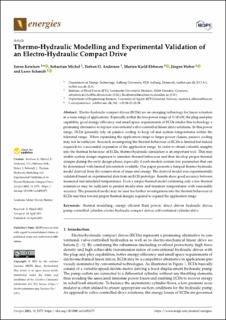Thermo-Hydraulic Modelling and Experimental Validation of an Electro-Hydraulic Compact Drive
Ketelsen, Søren; Michel, Sebastian; Andersen, Torben Ole; Ebbesen, Morten Kjeld; Weber, Jürgen; Schmidt, Lasse
Peer reviewed, Journal article
Published version
Permanent lenke
https://hdl.handle.net/11250/3070138Utgivelsesdato
2021Metadata
Vis full innførselSamlinger
Originalversjon
Ketelsen, S., Michel, S., Andersen, T. O., Ebbesen, M. K., Weber, J. & Schmidt, L. (2021). Thermo-Hydraulic Modelling and Experimental Validation of an Electro-Hydraulic Compact Drive. Energies, 14 (9), 1-29. doi: 10.3390/en14092375Sammendrag
Electro-hydraulic compact drives (ECDs) are an emerging technology for linear actuation in a wide range of applications. Especially within the low power range of 5–10 kW, the plug-and-play capability, good energy efficiency and small space requirements of ECDs render this technology a promising alternative to replace conventional valve-controlled linear drive solutions. In this power range, ECDs generally rely on passive cooling to keep oil and system temperatures within the tolerated range. When expanding the application range to larger power classes, passive cooling may not be sufficient. Research investigating the thermal behaviour of ECDs is limited but indeed required for a successful expansion of the application range. In order to obtain valuable insights into the thermal behaviour of ECDs, thermo-hydraulic simulation is an important tool. This may enable system design engineers to simulate thermal behaviour and thus develop proper thermal designs during the early design phase, especially if such models contain few parameters that can be determined with limited information available. Our paper presents a lumped thermo-hydraulic model derived from the conservation of mass and energy. The derived model was experimentally validated based on experimental data from an ECD prototype. Results show good accuracy between measured and simulated temperatures. Even a simple thermal model containing only a few thermal resistances may be sufficient to predict steady-state and transient temperatures with reasonable accuracy. The presented model may be used for further investigations into the thermal behaviour of ECDs and thus toward proper thermal designs required to expand the application range.

